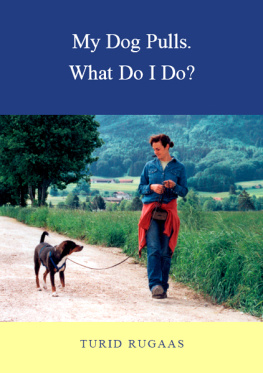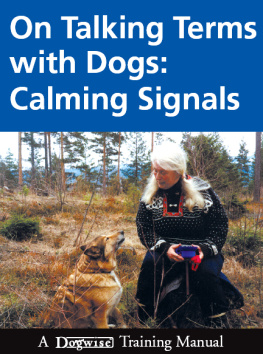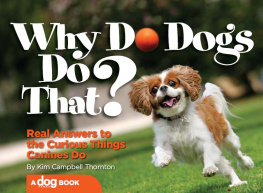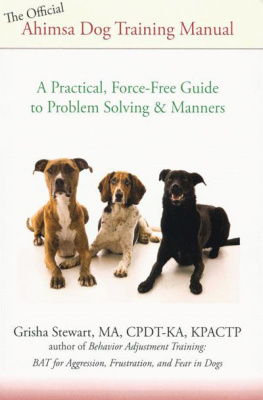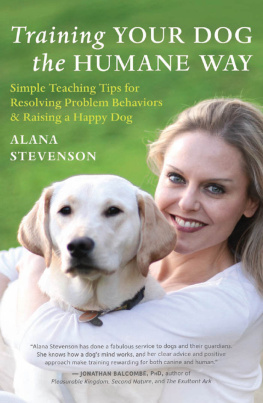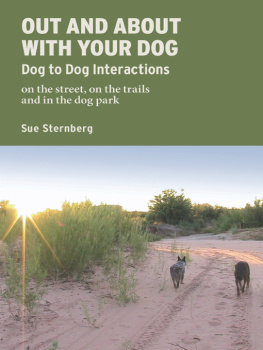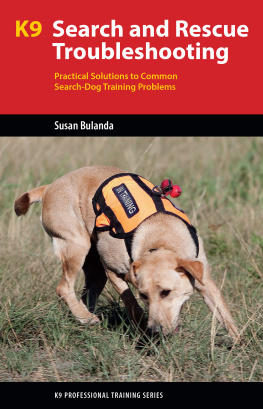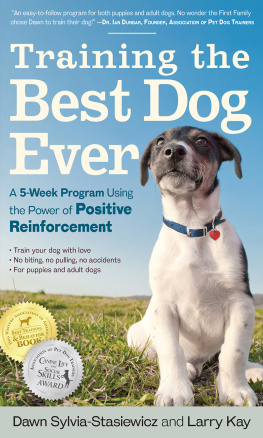

My Dog Pulls. What Do I Do?
Turid Rugaas
Dogwise Publishing
A Division of Direct Book Service, Inc.
PO Box 2778
701B Poplar
Wenatchee, Washington 98807
1-509-663-9115, 1-800-776-2665
website: www.dogwisepublishing.com
email:
2005 Turid Rugaas
Originally published in Norway under the title Hva gjor nar hnunden drar I bandet?
U.K. Editor Sheila Harper
Photos by Turid Rugaas, Kirsten Berger, Gerd Kohler and Sheila Harper
All rights reserved. No part of this book may be reproduced or transmitted in any form or by any means, electronic, digital or mechanical, including photocopying, recording or by any information storage or retrieval system without permission in writing from the publisher.
Limits of Liability and Disclaimer of Warranty:
The author and publisher shall not be liable in the event of incidental or consequential damages in connection with, or arising out of, the furnishing, performance, or use of the instructions and suggestions contained in this book.
Cataloging-in-Publication Data is available upon request from the Library of Congress.
ISBN: 1-929242-23-9
Printed in the U.S.A.
Contents
Sometimes I admire people.
I had a pupil and her dog coming toward me in a very unusual way some winters ago. Down the hill at full speed came the owner, sitting on the ground, legs stretched out in front of her, holding on to the leash of a very happy Bernese Mountain Dog. He had a smile all over his face and was galloping towards me very quickly, ears flapping and zest for life written all over him.
The owner was not quite so happy and was relieved when the dog stopped. She had had absolutely no chance of standing on her feet on the icy road, and so they made this spectacular entrance.
I like to help such great people and their dogs to be able to cope with whatever they encounter, and that is why I love the method I finally decided upon for walking with a dog on a slack leash. It really is a great tool for helping people to control the situation in a nice way.
From the Publisher
Norwegian dog trainer and behaviorist, Turid Rugaas, has enlightened and delighted dog owners and trainers worldwide with her research and insights into canine behavior and body language. With her flowing silver hair and Scandanavian simplicity, she persuades her audiences to view inter and intra-species communication in new and sympathetic ways.
Special thanks for editing the English language version of her work goes to Turids British editor, Sheila Harper, who preserved Turids voice and writing style while making the information accessible to the reader.
Over the years I have asked the pupils coming to my classes what they wanted to teach their dogs. The answer that topped the list was to walk nicely on leash.
Next on the list were to stop jumping on people," "to come when called, followed by a variety other things. However, walking nicely was definitely the winner.
Very understandable! I cant think of anything more annoying than walking a dog that is pulling away or lunging at dogs and bicycles. It can also be quite dangerous.
One winter some years ago, it was icy everywhere. It was difficult to stand up in the icy conditions and virtually impossible to hold dogs if they were pulling on leash. People were frequently falling over and breaking their bones. It was then that I made up my mind to look into and develop a method for teaching dogs to walk nicely on a loose leash and to prevent pulling if the dogs were to forget to keep the leash slack. Of course dogs can forget even if they have learned something well we all forget sometimes. Dogs are no different from us in this way.
I wanted to find a kind method, one that did not hurt, frighten or stress the dogs and most of the methods I had seen until then were not gentle.
I got the chance a little later while attending a one-year instructor course at Groruddalen Veterinary Clinic outside Oslo. We were asked to choose a project to work on for the year, and being a practical person I, of course, had to pick a practical project. I chose to develop a method for teaching dogs to walk nicely on leash.
It turned out to be great fun. I advertised for guinea pigs and received 204 replies right away; people who had dogs with a variety of pulling problems. The youngest was a collie pup of four months of age; the oldest a Norwegian Elkhound who was 14 years old.
All kinds of breeds, all ages and types of dogs were represented, along with all kinds of pulling problems.
To make the project work feasible and to get some valid results, I had to make the study rigid. Statistics are important to people, and I needed results that could be used and referred to.
In its simplicity I wanted to try out the following plan:
ignoring any unwanted behavior by standing still whenever the dog pulled on leash.
doing nothing apart from preventing the dog from being able to pull.
praising and rewarding the dog for walking nicely with the handler.
In order to get valid results we chose one particular stretch of road and counted every time the dog made the leash tight.
The method was very simple, and quite inflexible it has developed further and has been modified since then as I will show later.
Every dog taking part in the project was represented by its own graphic curve where the number of times it had pulled on the leash was marked each day, from day 1 to day 30. When everything was finished there were 196 curves, one for each dog finishing the project. They were so alike that I could have laid them on top of each other and made a carbon copy of the first one!
Then I made an average graph, which looked like this:
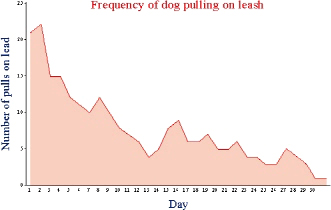
On average there were more than 70 pulls on leash on the first day. After 30 days the average number of pulls on the same stretch of road had dropped to only one, and that pull was barely noticeable.
After this project I was sure I was on the road to success. However, I had to adjust the method a little. I would have to start off by making it easier for the dogs to avoid becoming stressed, and making it easier for people to learn how to do it.
Little by little I tried out and developed my technique until I had refined it so well that it has become the method I use today. I have taught it to people all over the world, and now feel satisfied with it. It is simple enough for everybody to be able to use with a minimum of help and explanation, and it is also simple enough for dogs to learn quickly.
The feedback I receive is sometimes almost ecstatic, such as: I just LOVE that leash work of yours!
I am happy about this, as it often means a better life for a dog.
Lets look at this method now.
Lets look at this method as if it were a recipe. We need to be aware of the following:
Ingredients
One dog
One person
Harness or soft collar
Leash
Treats
Method the short version
Teach the dog to respond to a signal, for example clicking with your tongue.
STOP immediately when the leash becomes tightor is about to tighten.
WAIT two seconds stand still say nothing.
MAKE a clicking or smacking sound with the tongue or lips.
When the dog starts to turn his head toward you:
PRAISE him.
WALK a couple of steps in another direction and the dog will follow.
Next page
